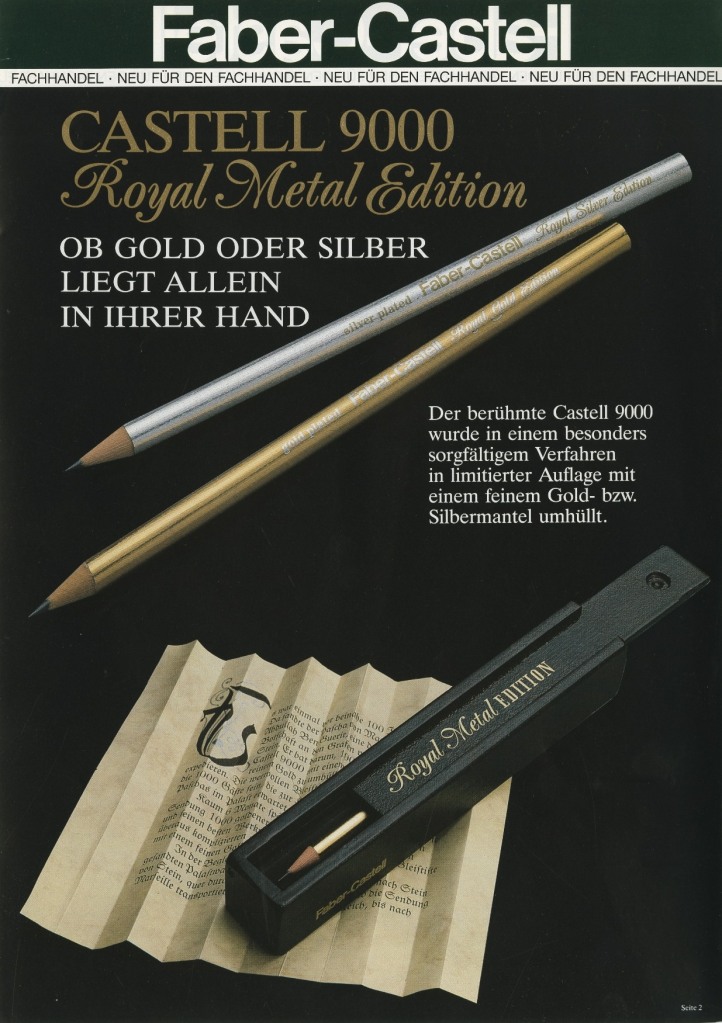Faber have produced a lot of special editions and limited editions over the years, most of which are not advertised very well. It can be tricky trying to track them all down, but a fun task nonetheless.
According to the kind people at Faber, the Royal Metal Edition was released in 1988 and sold in gold and silver plated versions.
Unfortunately, Faber confirmed that they don’t have any information about the price or quantities of the edition. They did note that they understood it was likely an HB or B grade used and it was a 9000 series under the plating.
There really isn’t too much more to say about these pencils, but as I have an example of both in my collection, let’s take a look, starting first with the advertisement presented to the trade.
This advert is the best place to really see the lettering on the pencils.

I think, but can’t be 100% sure, that I acquired both from German sellers over the years. I get the impression that this was a pretty limited release, and possibly only within Germany, but I don’t think we will ever know the exact answer to those questions.
Turning first to the boxes. Both the gold and silver editions came in the same style of box, with no distinguishing features. I’m trying to think back to remember if Faber released any other pencil in a wooden box in recent memory, and nothing is coming to mind.
The photo below shows the top of one box beside the side of another.

Inside the box is a v-shaped insert made of card, which allows the pencil to sit nicely for presentation. Underneath the card is the accompanying scroll. You can try and have the scroll sit folded above the pencil, but it becomes a pain trying to close the box lid.
I’m not entirely sure why they elected to change the typeface for the ‘EDITION’ on the box lid, it doesn’t really make any sense.

The pencils themselves are relatively plain, looking past the silver and gold plating of course. Each pencil simply has the type of plating, brand name and edition stamped in era appropriate lettering. Both pencils come factory sharpened.

What is interesting is that the pencil editions do not match the boxes. The boxes both say ‘Royal Metal Edition’ (as does the scroll), whereas the gold pencil says ‘Royal Gold Edition’ and the sliver, unsurprisingly, says ‘Royal Silver Edition’.
This seems a bit strange to me. Each pencil already states the plating and the edition is the ‘Royal Metal Edition’, so why create two new names here? Faber do this kind of strange design decision making from time to time, so it’s not unexpected.
The pencils have plated end caps:

Turning next to the scroll that comes with the pencil. It’s a neat extra and really adds to the special edition package. I remember reading the story and thinking it was pretty interesting and fun, but realistically, it did sound a little far-fetched, even for Faber.
I’ve set out the front and the back of the scroll below. It comes folded so that it can fit in the box. I’d be tempted to try and flatten one out with heat and then mount the pair if it worked.


I used the AI camera on my phone to auto translate the scroll. It’s not perfect, clearly, but it gives you the basic idea if you don’t read German.


You can of course find much more detail about this on Wikipedia, but in short, there doesn’t ever appear to have been a Pasha of Marrakesh named El Nehud Abdullah Ben Guerir. The closest we have was T’hami El Glaoui, known as “Lord of the Atlas”, who became Pasha of Marrakesh; a post he held virtually throughout the 44-year duration of the Protectorate (1912–1956).
It seems fairly clear to me that Faber most likely created this story as a bit of fun, and nothing more. I’d hazard a guess that Faber just fancied releasing gold and silver plated editions and needed to create a bit of a package to justify whatever money they ended up charging for these.

These pencils are amazingly shiny and so really quite difficult to take a photo of. The best photo is found within the Faber advert in this post – you can really make out the stamping.
You may have noticed that my last two posts step away from British made pencils. I don’t plan on doing it too often, but if the interest was there I would consider posting more about other European pencils in my collection.